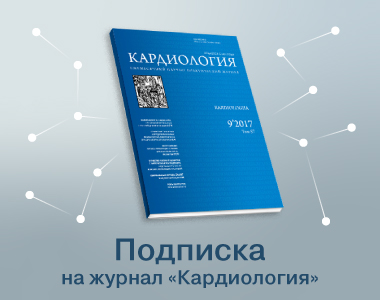Остановка сердца, клинические характеристики пациента и прогноз: подход, основанный на машинном обучении
https://doi.org/10.18087/cardio.2025.10.n2896
Аннотация
Введение. Остановка сердца — тяжёлое неотложное состояние с неблагоприятным прогнозом. Целью данного исследования был анализ клинических характеристик пациентов с остановкой сердца и изучение ключевых факторов, влияющих на исходы. Кроме того, мы применили методы машинного обучения для оценки эффективности различных моделей прогнозирования восстановления спонтанного кровообращения (ВСК) с целью оптимизации стратегий лечения остановки сердца.
Материал и методы: Мы провели комплексную оценку демографических характеристик, физиологических параметров и результатов лабораторных исследований 748 пациентов с остановкой сердца и сравнили различия между группами с ВСК и без ВСК. Мы применили регрессионный анализ LASSO для выявления ключевых предикторов восстановления спонтанного кровообращения. Кроме того, мы оценили эффективность различных моделей машинного обучения, включая GBDT и LGBM, в прогнозировании ВСК, по качеству калибровки, анализу кривой принятия решений и ROC-кривых.
Результаты: Пациенты в группе с ВСК были моложе и преимущественно мужчинами. У них чаще наблюдались нормальные показатели артериального давления, температуры и сатурации кислорода, а также менее выраженная органная дисфункция. Регрессионный анализ LASSO определил возраст, количество лейкоцитов и уровень лактата в качестве ключевых предикторов восстановления спонтанного кровообращения. Среди моделей машинного обучения GBDT и LGBM показали наилучшую эффективность, продемонстрировав превосходную калибровку, а также по данным анализа кривой принятия решений и ROC-кривых.
Выводы: В данном исследовании были выявлены ключевые клинические факторы, влияющие на прогноз у пациентов с остановкой сердца, и были выявлены модели машинного обучения, которые превосходили другие методы для прогнозирования восстановления спонтанного кровообращения.
Об авторах
Юй ЧжанКитай
BD
Шаосин, Китай
Хефэн Тан
Китай
MD
Шаосин, Китай
Липин Ин
Китай
BD
Шаосин, Китай
Ли Чжан
Китай
MD
Шаосин, Китай
Лин Чжан
Китай
BD
Шаосин, Китай
Список литературы
1. Bakhsh A, Bakhashwain W, Alhazmi M, Bahwireth S, Binmahfooz S, Alghamdi R et al. Fever Prevention and Neurological Recovery in In-Hospital Cardiac Arrest Survivors at a Limited-Resource Setting. Therapeutic Hypothermia and Temperature Management. 2025; [Epub ahead of print]. DOI: 10.1089/ther.2024.0051
2. Jakobsen LK, Kjærulf V, Bray J, Olasveengen TM, Folke F. Drones delivering automated external defibrillators for out-of-hospital cardiac arrest: A scoping review. Resuscitation Plus. 2025;21:100841. DOI: 10.1016/j.resplu.2024.100841
3. Jeong D, Tak Lee G, Eun Park J, Yeon Hwang S, Gun Shin T, Do Shin S et al. Severity of metabolic derangement predicts survival after out-of-hospital cardiac arrest and the likelihood of benefiting from extracorporeal life support. Emergencias. 2024;36(6):408–16. DOI: 10.55633/s3me/093.2024
4. Motta F, Cerrato M, De Giorgio D, Salimbeni A, Merigo G, Magliocca A et al. Translational approach to assess brain injury after cardiac arrest in preclinical models: a narrative review. Intensive Care Medicine Experimental. 2025;13(1):3. DOI: 10.1186/s40635-024-00710-y
5. Breuer-Kaiser AFC, Lefering R, Weber TP, Gräsner J-T, Wnent J. Use of CPR feedback devices to treat out-of-hospital cardiac arrest in Germany: Associated with improved ROSC-rates, but infrequent usage, in a registry-based analysis of 107,548 cases. Resuscitation. 2024;110453. [Epub ahead of print]. DOI: 10.1016/j.resuscitation.2024.110453
6. Caputo ML, Baldi E, Burkart R, Wilmes A, Cresta R, Benvenuti C et al. Validation of Utstein-Based score to predict return of spontaneous circulation (UB-ROSC) in patients with out-of-hospital cardiac arrest. Resuscitation. 2024;197:110113. DOI: 10.1016/j.resuscitation.2024.110113
7. Dombrowski A, Curtis K, Wisniewski S, Nichols J, Irish L, Almahameed S et al. Post-ROSC Atrial fibrillation is not associated with rearrest but is associated with stroke and mortality following out of hospital cardiac arrest. Resuscitation. 2024;201:110270. DOI: 10.1016/j.resuscitation.2024.110270
8. Hubble MW, Martin MD, Kaplan GR, Houston SE, Taylor SE. The Route to ROSC: Evaluating the Impact of Route and Timing of Epinephrine Administration in Out-of-Hospital Cardiac Arrest Outcomes. Prehospital Emergency Care. 2025;29(6):826–34. DOI: 10.1080/10903127.2024.2414389
9. Choi H-J, Lee C, Chun J, Seol R, Lee YM, Son Y-J. Development of a Predictive Model for Survival Over Time in Patients With Out-of-Hospital Cardiac Arrest Using Ensemble-Based Machine Learning. Computers, Informatics, Nursing. 2024;42(5):388–95. DOI: 10.1097/CIN.0000000000001145
10. Kim YK, Seo W-D, Lee SJ, Koo JH, Kim GC, Song HS et al. Early Prediction of Cardiac Arrest in the Intensive Care Unit Using Explainable Machine Learning: Retrospective Study. Journal of Medical Internet Research. 2024;26:e62890. DOI: 10.2196/62890
11. Soundararajan K, Adams DJ, Nathanson BH, Mader TJ, Godwin RC, Melvin RL et al. Use of machine learning models to predict neurologically intact survival for advanced age adults following out‐of‐hospital cardiac arrest. Academic Emergency Medicine. 2025;32(2):169–71. DOI: 10.1111/acem.15018
12. Wu W, Kor C, Chou M, Hsieh H, Huang W, Huang W et al. Prediction model of in‐hospital cardiac arrest using machine learning in the early phase of hospitalization. The Kaohsiung Journal of Medical Sciences. 2024;40(11):1029–35. DOI: 10.1002/kjm2.12895
13. Karatsu S, Hirano Y, Kondo Y, Okamoto K, Tanaka H. A Machine Learning Prediction Model for Non-cardiogenic Out-of-hospital Cardiac Arrest with Initial Non-shockable Rhythm. Juntendo Medical Journal. 2023;69(3):222–30. DOI: 10.14789/jmj.JMJ22-0035-OA
14. Lee H-Y, Kuo P-C, Qian F, Li C-H, Hu J-R, Hsu W-T et al. Prediction of In-Hospital Cardiac Arrest in the Intensive Care Unit: Machine Learning–Based Multimodal Approach. JMIR Medical Informatics. 2024;12:e49142. DOI: 10.2196/49142
15. Lee S, Lee K-S, Park S-H, Lee SW, Kim SJ. A Machine Learning-Based Decision Support System for the Prognostication of Neurological Outcomes in Successfully Resuscitated Out-of-Hospital Cardiac Arrest Patients. Journal of Clinical Medicine. 2024;13(24):7600. DOI: 10.3390/jcm13247600
16. Zheng X, Hu T, Liu T, Wang W. Simplified acute physiology score III is excellent for predicting in-hospital mortality in coronary care unit patients with acute myocardial infarction: A retrospective study. Frontiers in Cardiovascular Medicine. 2022;9:989561. DOI: 10.3389/fcvm.2022.989561
17. Kokulu K, Sert ET. The role of the lactate/albumin ratio in predicting survival outcomes in patients resuscitated after out-of-hospital cardiac arrest: A preliminary report. The American Journal of Emergency Medicine. 2021;50:670–4. DOI: 10.1016/j.ajem.2021.09.059
18. Kong T, Chung SP, Lee HS, Kim S, Lee J, Hwang SO et al. The Prognostic Usefulness of the Lactate/Albumin Ratio for Predicting Clinical Outcomes in Out-of-Hospital Cardiac Arrest: a Prospective, Multicenter Observational Study (koCARC) Study. Shock. 2020;53(4):442–51. DOI: 10.1097/SHK.0000000000001405
19. Beaulieu J, St-Onge M. Antidote use for cardiac arrest or hemodynamic instability due to cardiac glycoside poisoning: A narrative review. Resuscitation Plus. 2024;19:100690. DOI: 10.1016/j.resplu.2024.100690
20. Dogan B, Kudu E, Danış F, Ozturk Ince E, Karaca MA, Erbil B. Comparative Analysis of Perfusion Index and End-Tidal Carbon Dioxide in Cardiac Arrest Patients: Implications for Hemodynamic Monitoring and Resuscitation Outcomes. Cureus. 2023;15(2):e50818. DOI: 10.7759/cureus.50818
21. Linde L, Beske RP, Meyer MAS, Mølstrøm S, Grand J, Helgestad OKL et al. Hemodynamic Characteristics and Prognostic Implication of Modified Society for Cardiovascular Angiography and Interventions Shock Classification in Comatose Patients With Out‐of-Hospital Cardiac Arrest. Journal of the American Heart Association. 2025;14(1):e036659. DOI: 10.1161/JAHA.124.036659
22. Seppä AMJ, Skrifvars MB, Vuopio H, Raj R, Reinikainen M, Pekkarinen PT. Association of white blood cell count with one-year mortality after cardiac arrest. Resuscitation Plus. 2024;20:100816. DOI: 10.1016/j.resplu.2024.100816
23. Szarpak L, Kurek K, Tomaszewska M, Pruc M. Lactate-to-albumin ratio in predicting neurological outcomes in patients who have survived cardiac arrest. The American Journal of Emergency Medicine. 2024;85:260–1. DOI: 10.1016/j.ajem.2024.08.002
24. Xiao L, Li F, Sheng Y, Hou X, Liao X, Zhou P et al. Predictive value analysis of albumin-related inflammatory markers for short-term outcomes in patients with In-hospital cardiac arrest. Expert Review of Clinical Immunology. 2025;21(2):249–57. DOI: 10.1080/1744666X.2024.2399700
25. Xie Y, Wang R. Enhancing neurological prognosis prediction in cardiac arrest survivors: Insights from lactate-to-albumin ratio and cholesterol levels. The American Journal of Emergency Medicine. 2024;85:258–9. DOI: 10.1016/j.ajem.2024.07.058
26. Drkic T, Sljivo A, Ljuhar K, Palikuca A, Knezevic A, Karamehic E et al. Outcomes of Out-of-Hospital Cardiac Arrest with Initial Shockable Rhythm: The Role of Bystander and Dispatch-Guided CPR in Sarajevo’s Physician-Led Emergency Medical Teams. Materia Socio Medica. 2024;36(2):115–9. DOI: 10.5455/msm.2024.36.115-119
27. Simpson R, Dankiewicz J, Nielsen N, Pareek N, Keeble TR. Coronary artery disease and outcomes in Out of Hospital Cardiac arrest according to presenting rhythm − A post hoc analysis of the TTM-2 trial. Resuscitation. 2025;206:110457. DOI: 10.1016/j.resuscitation.2024.110457
Рецензия
Для цитирования:
Чжан Ю., Тан Х., Ин Л., Чжан Л., Чжан Л. Остановка сердца, клинические характеристики пациента и прогноз: подход, основанный на машинном обучении. Кардиология. 2025;65(10):91-100. https://doi.org/10.18087/cardio.2025.10.n2896
For citation:
Zhang Yu., Tang H., Ying L., Zhang L., Zhang L. Cardiac Arrest, Patient Characteristics and Prognosis: a Machine Learning Approach. Kardiologiia. 2025;65(10):91-100. https://doi.org/10.18087/cardio.2025.10.n2896
















